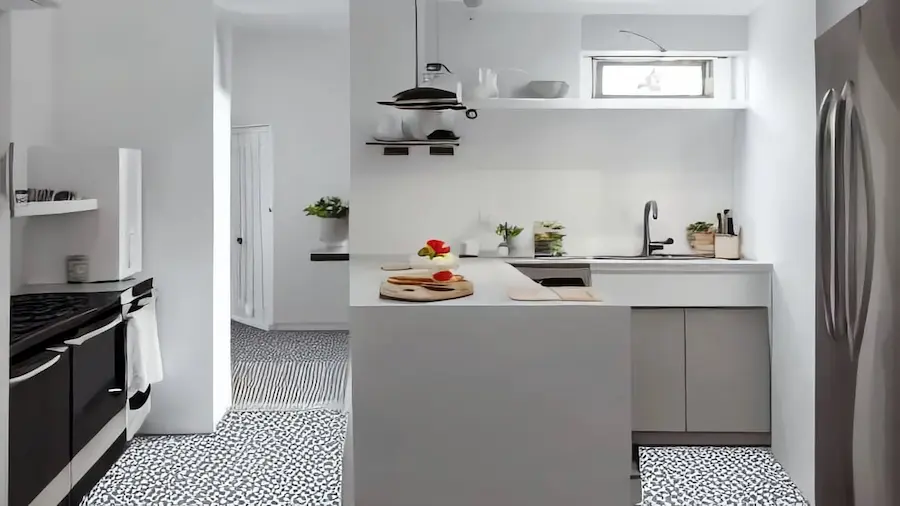~ 6 min read
Can You Put Carpet in the Kitchen? Pros, Cons, and Tips

While the kitchen is often the heart of the home, it’s not always the most pleasant place to be. You spend much time in the kitchen preparing meals, doing dishes, and running into other people. Putting carpet in your kitchen can be the ultimate solution to some problems. It’s soft, warm, and comfortable underfoot.
However, it has some drawbacks you need to consider before installing carpet in your kitchen.
What are the pros and cons of putting carpet in the kitchen?
The pros of kitchen carpets can be boiled down to a simple fact: the carpet is warm. If you have wood or tile floors, you know how much colder these get than carpeting. This coolness can be a problem in a room that you use a lot, like the kitchen. Carpet can help to even temperatures so that you don’t get as chilly in the kitchen.
The main drawback of kitchen carpets is that they can create a lot of dirt. You will probably want to clean your carpet regularly. It may not be a good idea to install carpet in a kitchen you rent. Renters may not be allowed to install carpets.
What are some tips for putting carpet in the kitchen?
Carpet in the kitchen is uncommon, but it is not impossible. Many ceramic tiles have a rough surface that is not very comfortable to stand on barefoot. Even if you have a smooth ceramic tile, you might not like the feeling of grit between your bare toes. A small rug placed in front of the stove or sink can help reduce the amount of foot traffic in the kitchen.
You can use a kitchen rug to define your workspace if you have a large kitchen. If you have a small kitchen, you can put a rug in front of your stove, sink, and island.
If you have carpet in your home and want to keep it looking good, consider installing mats at the entrances of high-traffic areas.
How do you choose the right carpet for the kitchen?
Natural fibers are the best choice for a kitchen floor since they are often stain-resistant and naturally non-slip. But there are still a few things to remember when choosing the right carpet for your kitchen.
Make sure it has a non-slip backing. A unique, textured backing often makes natural fibers like wool and jute highly non-slip. But make sure the non-slip feature is not made with low-traction, high-pile velcro-like hooks, which will create a lot of dust and be difficult to keep clean.
The kitchen contains grease and grime, so you need a low-maintenance carpet. Don’t choose a carpet that is so low-maintenance as ugly. Find one that is beautiful and you love to look at.
Consider the color carefully. Consider the colors you want to bring out in your kitchen, like the red in tomatoes or the blue in a platter of sky-blue sea salt, and make sure that the colors of your carpet complement those colors.
How do you install carpet in the kitchen?
There are many ways to add carpeting to your kitchen, but the simplest way is to purchase individual rugs to create a pathway that leads to the kitchen entrance or other vital areas.
This great way to add carpet to your kitchen without committing to a complete installation. You can purchase rugs as you have the money and replace them as needed. You can also move rugs around to create a pathway to certain areas.
There are two main types of kitchen rugs: runner rugs and low-pile rugs.
A runner rug is a long, narrow rug often placed in front of your sink. This type of rug is excellent for moving back and forth over tiled floors, which can be slippery.
Low-pile rugs, known as shag rugs, are thick, luxurious rugs that are soft to stand on. They can also be quite expensive. You need to vacuum low-pile rugs thoroughly to keep them looking good.
How do you care for carpets in the kitchen?
The carpet in the kitchen can be functional and warm, but it needs regular cleaning. Even if you have a low pile, you should vacuum every day. Twice a day if you have lots of feet in your kitchen.
If you have a carpeted kitchen, you must quickly clean up spills and messes. This can be challenging since many things will soak into the fibers and create stains.
Getting any spills or messes up as soon as they happen is essential. For example, if you spill red wine or another dark liquid, you should immediately blot with a towel. If you wait too long, you may need to use a commercial stain remover.
Carpet can also trap odors. Make sure you have an excellent deodorizer on hand to use after you clean. Or, add a natural deodorizer like baking soda to the carpet.
You should vacuum with a low-pile setting or attachment for a beautiful carpet. If you have a suction attachment, you should use it, too.
For the best results, vacuum with the best suction attachment. Then, go over the carpet with the passion that has the lowest number of “picks per inch” (or “tufts per square inch”).
Carpets in the kitchen can benefit from a steam clean once or twice a year. This can help you remove stains and deep clean the carpet.
There are pros and cons to putting carpet in the kitchen, but ultimately it is a decision that comes down to personal preference. If you decide to put carpet in your kitchen, there are a few things to keep in mind to keep it clean and in good condition. You can enjoy your kitchen carpet for years with some care and attention.
Related Reading: